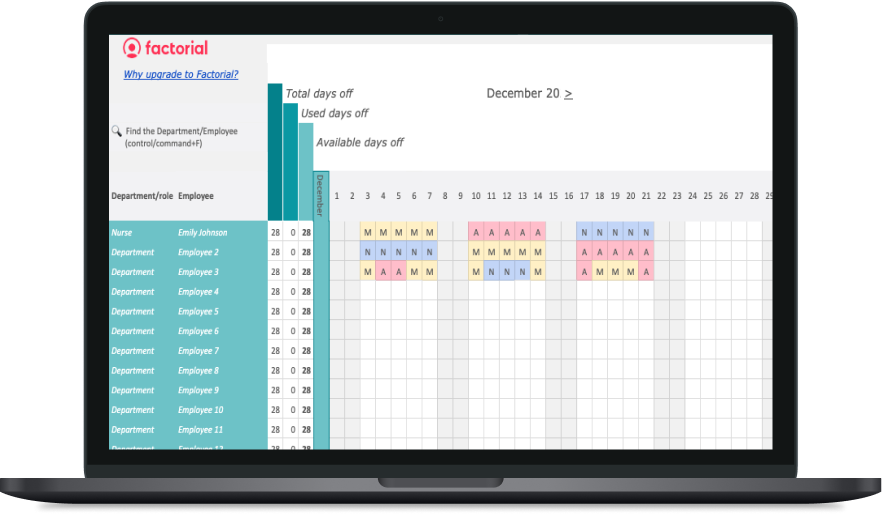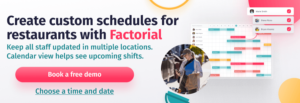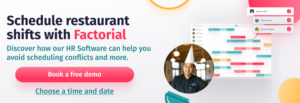The food service sector has grown a lot in recent years. On the other hand, the internal management of bars and restaurants needs an update. From hiring to managing restaurant staff, managers face a series of and unique operational and HR challenges. Restaurant shifts are one of the most difficult to get right. Your restaurant can serve the best fries in the state, but without proper shift scheduling, you’ll be aboard a sinking ship. In this article, we’ll tackle the unique shift scheduling problems of running a restaurant as well as how software can help you stay on top.
Restaurant Shift Scheduling Tips
Scheduling shifts can be hard to juggle, particularly when you consider everyone’s availability and the business needs. Which is why finding the perfect balance between accommodating your team and ensuring you are thinking about what’s best for the business can be so difficult. Here are seven tips for effective restaurant employee scheduling. Follow these basic scheduling tips to keep your team happy while running a more efficient business.
👉 Download your free shift schedule template
1. Create Restaurant Schedules for Peak Hours First
Identify the busiest and slowest times in your restaurant. Schedule more staff during peak hours to provide efficient service and fewer during slower periods to control labor costs.
2. Use Employee Preferences
Whenever possible, consider your employees’ availability and preferences when creating schedules. This can lead to happier and more motivated staff.
3. Rotate Shifts Fairly
To distribute the workload evenly, use a fair rotation system for shifts. Ensure that employees take turns working during evenings, weekends, and holidays to prevent burnout and maintain work-life balance.
4. Plan for Breaks
Don’t forget to schedule breaks for your employees. Ensure that they have adequate time for rest and meals, as well as adherence to labor laws regarding breaks and overtime.
5. Leverage Restaurant Scheduling Software
Invest in scheduling software that can automate the process, taking into account labor laws, employee availability, and demand fluctuations. This can save time and reduce scheduling errors. Additionally, leveraging technology like restaurant scheduling software allows you to manage schedules more easily and have full visibility into your workforce.
6. Avoid Scheduling Back-to-Back Shifts
Be considerate when creating your restaurant schedules and avoid assigning any of your employees a “double” shift. Or back-to-back shifts, for example, an employee working both the closing and opening shifts. This could potentially negatively impact your team and by extension your business as there is little time in between to properly rest.
7. Make Restaurant Schedules Visually Appealing
Make sure your schedule is easy to read. That makes it easier and faster for your staff to identify their work days and avoid any miscommunication.
By following these tips, you can create restaurant schedules that are more efficient, fair, and employee-friendly.

Restaurant Schedules
Common Restaurant Shift Types
Scheduling the right shifts is like orchestrating the perfect performance. Restaurants typically employ various shift types to meet the ever-changing demands of the industry. Let’s look at some of the common shift types you’ll find in restaurants:
1. Morning Shifts
Morning shifts usually begin before the restaurant opens its doors for breakfast or brunch service. These shifts are ideal for early risers and are essential for setting up the restaurant, preparing ingredients, and ensuring a smooth start to the day.
2. Lunch Shifts
Though less common, the lunch shift bridges the gap between the early morning and the busier evening periods. It’s a shorter shift that caters to diners seeking a midday meal. Lunch shifts are often a great fit for those who prefer a more traditional work schedule.
3. Dinner Shifts
The dinner shift is the main event for many restaurants. It starts in the late afternoon and extends into the evening, encompassing the restaurant’s peak hours. This shift type demands a well-coordinated staff to handle the influx of customers.
4. Split Shifts
Some restaurants employ split shifts, where employees work both the lunch and dinner shifts with a break in between. While this type can be challenging, it provides an opportunity for part-time staff to maximize their earnings.
5. Closing Shifts
The closing shift, often referred to as the “closing crew,” is responsible for shutting down the restaurant after dinner service. They clean, restock, and ensure that everything is in order for the next day. Closing shifts are typically more labor-intensive and can extend late into the night.
6. Double Shifts
Double shifts involve working both the morning and evening shifts within the same day. This can be demanding, but it’s an efficient way to schedule employees during the busiest days or for those who prefer longer hours on fewer days.
7. Weekend and Holiday Shifts
Weekends and holidays are high-demand periods for restaurants. Staff working these shifts must be prepared for a fast-paced and bustling environment. They often require advanced planning and flexibility from both management and staff.
8. On-Call or Standby Shifts
Some restaurants have on-call or standby shifts for employees who are available to come in when needed. This approach allows for flexibility in staffing based on unexpected fluctuations in customer traffic.
Understanding the nuances of these shift types and effectively managing them is vital to optimizing the restaurant’s operations. It’s important for restaurant managers to create balanced schedules that consider employee availability, preferences, and the restaurant’s needs to ensure a seamless dining experience for customers.
Restaurant Scheduling Template
If you need help with scheduling shifts try this free shift schedule template for your restaurant. It’s not as effective as shift scheduling software, but it can do the trick. For other options, scroll down.
Restaurant Scheduling Benefits
Effective restaurant scheduling plays a crucial role in the success of your business. Balancing operational efficiency with employee satisfaction can be challenging – what’s best for the restaurant isn’t always what’s best for the team. However, a well-thought-out employee scheduling strategy can help you achieve both.
Key benefits of effective restaurant scheduling:
-
Improved customer service during peak hours
-
Clear visibility into labor costs
-
Increased staff satisfaction through fair and flexible scheduling
-
More efficient and streamlined scheduling processes
Restaurant Scheduling Challenges
The past few years have been tumultuous for the restaurant industry. Recent statistics show a turnover rate of 144% in US fast food restaurants, while data from the US Department of Labor shows that restaurant workers are quitting at the highest rate in two decades.
Why do restaurant workers quit?
Restaurant workers may decide to quit their jobs for a variety of reasons, and many of these reasons can be related to issues within the workplace. Here are some key factors that can lead to restaurant workers quitting:
1. Bad Management
Poor management practices, such as inconsistent leadership, favoritism, or a lack of communication, can create a hostile work environment and make employees feel undervalued.
| 💡 Effective leadership is the cornerstone of a successful workplace, but with so many different management styles, how do you know which one is best for you? Learn more about management styles. |
2. Unempathetic Managers
Managers who lack empathy and understanding for their staff’s needs and concerns can drive employees away. Empathy is crucial in addressing personal and professional challenges.
| 💡 An effective leader needs to be an emotionally intelligent leader. Take a look at 6 habits of emotionally intelligent leaders to help you understand which leadership qualities you should be developing. |
3. Poor Shift Planning
Inadequate shift planning can result in erratic restaurant shift schedules that disrupt work-life balance. Employees may struggle to cope with unpredictable hours, leading to dissatisfaction and eventually quitting.
| 💡 Maintaining a balanced schedule helps businesses keep the floor covered, customers happy, and goals in sight. Shift managers who have a lot to worry about rely on a shift scheduler to keep their employee calendar in tip-top shape. Learn more about shift management here. |
4. No Shift Scheduling in Advance
When employees are not provided with schedules well in advance, it can be challenging for them to plan their lives outside of work. Last-minute schedules can create stress and conflict with personal commitments.
| 💡Explore the most common scheduling issues and solutions. Addressing these challenges help you establish a more efficient scheduling system for your business, enhance your employee experience, and boost the overall output of your business. |
5. Difficult to Request PTO
A lack of flexibility in requesting time off (PTO) can discourage employees from taking much-needed breaks. When employees feel they can’t maintain a healthy work-life balance, they may seek other job opportunities.
| 💡 PTO can be a headache to manage. Learn how to simplify the process in our guide to managing employee paid time off requests. |
6. Non-Compliance with Overtime and Labor Laws
Violations of labor laws, such as unpaid overtime or improper meal and rest breaks, can lead to frustration and legal concerns. Employees may leave in search of better employment conditions.
| 💡 As an employer, one of the most important responsibilities you have is complying with federal and state labor laws and regulations. There are many important laws HR should stay aware of, few are as important as the laws concerning time and attendance. |
7. Lack of Cross-Training
A lack of cross-training can limit opportunities for career growth and skill development. Employees who want to expand their skills and responsibilities may leave if those opportunities are not available.
| 💡 Training programs are one of the vital aspects of managing your employees as they equip the organization with competitive advantages and countless benefits. Learn more about training programs for employees. |
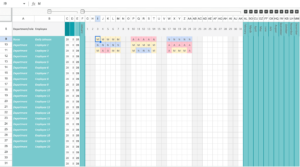
Download this restaurant scheduling template!
Addressing these issues through better management practices, consistent scheduling, adherence to labor laws, and providing opportunities for professional development and cross-training can help reduce turnover and improve retention in the restaurant industry. But how to start? Let’s take a look at scheduling tips for running a restaurant, common restaurant shift schedule types, and how HR software can help make things run more smoothly.
Restaurant Employee Scheduling Software
A Human Resources (HR) management and employee scheduling software solution can significantly alleviate many of the challenges faced by restaurant workers and management.

Here’s how Factorial can address the restaurant issues mentioned:
1. Effective Management: Factorial provides powerful HR management tools that enable better organization, communication, and transparency within your restaurant team. Managers can use the platform to streamline HR tasks, track performance, and ensure fair treatment of all employees.
2. Empathy and Communication: Factorial’s employee management features include channels for communication, feedback, and recognition. This fosters a more empathetic work environment where both employees and managers can express concerns, offer support, and acknowledge hard work.
3. Shift Planning: Factorial simplifies shift planning by allowing managers to create schedules efficiently. Employees can access their schedules well in advance, even via mobile app, promoting work-life balance and better planning for personal commitments.

4. Advanced Scheduling: The software’s scheduling features enable managers to plan shifts in advance. The result is more predictable and manageable work hours for the staff.
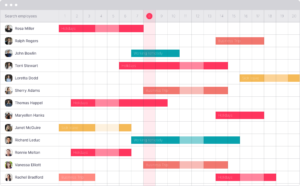
5. Requesting PTO: Factorial offers a user-friendly PTO request system, making it easy for employees to request time off. Managers can quickly approve or decline requests, ensuring a smooth process for taking breaks.
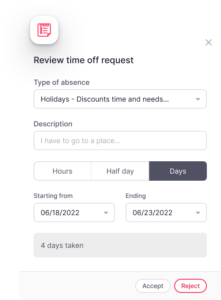
6. Compliance with Labor Laws: Factorial helps maintain compliance with labor laws and regulations by tracking overtime, rest periods, and other legal requirements. This reduces the risk of labor law violations.
7. Training and Development: Factorial facilitates employee training and development by providing tools for tracking skills and qualifications. This enables cross-training and career growth opportunities within the restaurant.
Factorial is a comprehensive software solution that not only simplifies HR and restaurant shift scheduling but also enhances the overall work environment for restaurant staff. By addressing these common challenges, Factorial can contribute to better retention rates, improved job satisfaction, and a more efficient, legally compliant restaurant operation. Get your free demo to learn more!
